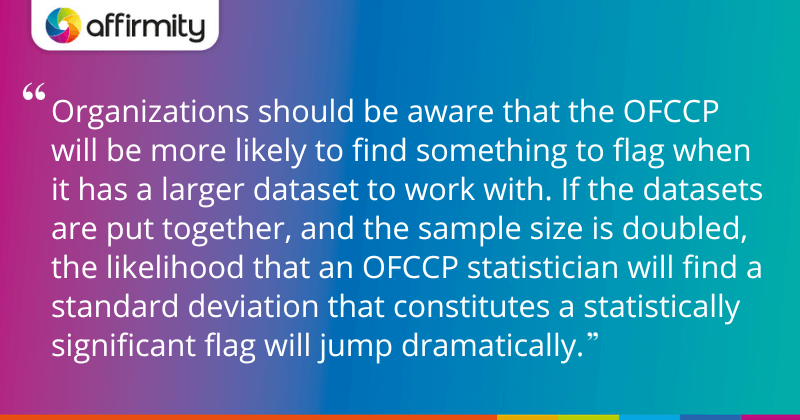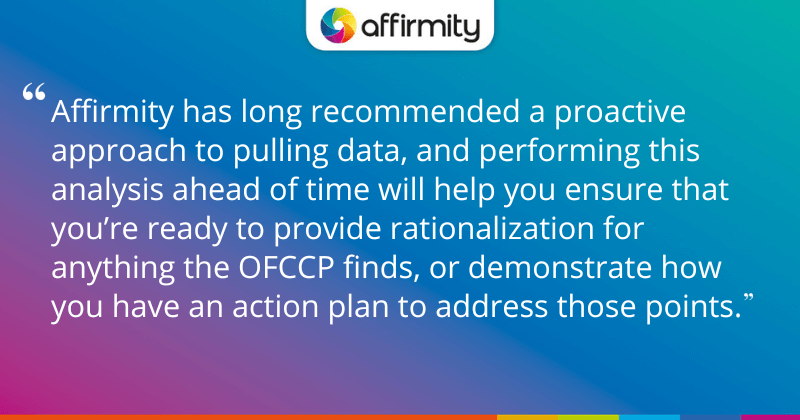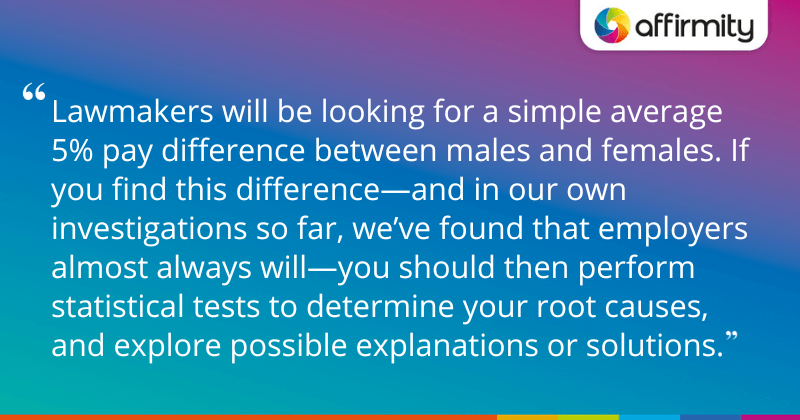Changes made to the OFCCP scheduling letter in August 2023 have big implications for federal contractors who remain appropriately vigilant for the prospect of an audit. Meanwhile, a new directive in the European Union will create new challenges for globally-engaged organizations. In this article, Affirmity’s lead statistician Charles McGhee, PhD looks at everything you need to know to remain compliant.
OFCCP Scheduling Letter Item 19: The Two-Year Requirement
The scheduling letter changes announced by the OFCCP in August 2023 have implications across a wide range of areas, including selection and other aspects of compliance, but in terms of compensation, the main changes concern items 19 and 22. It’s absolutely critical that all contractors are made aware of these changes, as some teams who haven’t been keeping up with the latest news could easily get caught out.
As of August 25, 2023, Item 19 now requires two years’ worth of compensation data: a current- and preceding-year snapshot. Prior to this date, the OFCCP required only a single year of data.
While this data may involve some overlap (i.e., people with you last year who are still with you this year), the requirement of two distinct datasets is a substantial one, especially within the 30-day deadline that contractors are given when they receive their scheduling letter.
It’s not entirely unusual for OFCCP auditors to have access to prior year’s data—it would often request it later in its auditing process. Starting with just your current year’s data, they would run statistics and regression models, and if they ended up with a statistical indicator or flag, they would request your previous year’s data (or potentially further back than that). However, they can now gain access to data outside the review period without providing a rationale for doing so.

What Will the Two-Year Requirement Mean for Organizations Subject to Audit?
The new requirement once again reinforces the importance of performing annual pay equity evaluations as a matter of procedure: scrambling to pull and quality-assure two datasets in just 30 days is unrealistic. Add in the possibility that your letter will already be a few days old when it comes to your attention (and also, the lack of extensions currently being granted for the process), and such an approach seems untenable.
Ensuring you’re in a position to provide both years of data is a critical first step to proving compliance. However, organizations should be aware that the OFCCP will be more likely to find something to flag when it has a larger dataset to work with. If the datasets are put together, and the sample size is doubled, the likelihood that an OFCCP statistician will find a standard deviation that constitutes a statistically significant flag will jump dramatically.
Refresh Your Scheduling Letter Knowledge | ‘What Are the 26 Items on the OFCCP’s Scheduling Letter and Itemized Listing?’

OFCCP Scheduling Letter Item 22: Compensation System Evaluation
We first heard rumblings of a new rule requiring federal contractors to evaluate their compensation system for disparities back in a draft directive in January 2022. Wording around this requirement was then integrated into the updated scheduling letter in August 2023.
However, though Item 22 tells you that you must provide this documentation evidencing that you have evaluated your “compensation system(s) to determine whether there are gender-, race-, or ethnicity-based disparities”, it’s pretty open-ended on how you go about doing that.
The standard parameters for your documentation include:
- Providing the date the report was completed
- The number of employees included, and the number and categories of employees excluded.
- Examples of data you may exclude could include jobs within your organization with only females or males or one race or ethnicity. As you lack a comparator for these groups, it would be acceptable to exclude them from your analysis.
- The OFCCP has previously advised that it wants 70% of the workforce to go into the analysis model used, though this may not always be realistic.
- The forms of compensation you analyzed.
- Examples may include base pay, total compensation, variable pay, overtime, bonus incentives, and commission, totals from the previous 12 months from the plan or effective date.
- If applicable, you should also describe how the different forms of compensation were separated or combined for analysis.
- The method of analysis you employed, for example:
- Multiple regression analysis
- Decomposition regression analysis
- Meta-analytic tests of z-scores
- Compa-ratio regression analysis
- Rank-sum tests
- Career-stall analysis
- Average pay ratio
- Cohort analysis
Of the analysis types listed, it’s notable that multiple linear regression is the statistical method that the government uses almost to the exclusion of everything else. Additionally, some of the proposed approaches would be complicated by the two years of data requirement in Item 19.
Affirmity has long recommended a proactive approach to pulling data, and performing this analysis ahead of time will help you ensure that you’re ready to provide rationalization for anything the OFCCP finds, or demonstrate how you have an action plan to address those points.
Contractors should also note that the following factors and fields should be provided with their submission:
- Salary grade/band
- Education
- Performance ratings (multiple years)
- Prior experience
- Date of birth
- Plan year
Contractors may not have all of these fields available electronically and will have to account for any missing fields (for example, the contractor may collect paper documentation such as resumes on which the missing fields can be found). While the OFCCP may accept these explanations, organizations are cautioned that by not having these fields available to be used in their own models, they will have fewer chances to understand any pay differences they uncover. It can also be particularly problematic if, for example, you are a “pay for performance” company that cannot produce and demonstrate how you control for performance data.
GET AN OVERVIEW OF THE PAY EQUITY LANDSCAPE | ‘4 Key Insights From the 2023-24 State of Pay Equity Report’

EU Directive 2023/970: Upcoming Global Laws With a Different Statistical Approach
Organizations with global operations in Europe must also be aware of new legislation being implemented in the EU’s member states. EU Directive 2023/970 “to strengthen the application of the principle of equal pay for equal work or equal work of equal value between men and women through pay transparency and enforcement mechanisms” was signed on 10 May 2023. It compels all 27 member states to implement the directive in their national laws. The UK, now a non-member state, additionally has laws aligned with the EU.
This directive and its resulting national laws will apply to your organization if you operate in the EU and meet the following employee thresholds:
- Employers with 250 or more workers must provide their first report by June 7, 2027 (relating to 2026 data). They will need to make subsequent reports annually thereafter.
- Employers with 150 to 249 workers will also provide their first report by June 7, 2027, but they only need to make subsequent reports every three years thereafter.
- Employers with 100 to 149 workers will be required to provide their first report by June 7, 2031 (relating to 2030 data). They will also need to make subsequent reports on a three-year schedule thereafter.
- Employers with fewer than 100 workers will not have a reporting requirement under the directive, although they may voluntarily report. Note that individual member states may make rules specific to this threshold.
We should note that the EU is concerning itself with what it calls a “pay gap” rather than “pay equity”. Whereas US statisticians’ approach to the concept of pay equity involves trying to put similar people together for analysis purposes and control for factors that went into those decisions, the pay gap is more straightforwardly just taking the two groups and comparing the average difference between them. There’s no statistical test (hypothesis test) or consideration of standard deviation.
So when you have a workforce where, for example, women are in entry-level or lower-paying jobs, and men are in upper-level positions, you’re likely to have a large pay gap.
Note also that in the EU context, the groups studied are almost exclusively male/female. There’s some wording around intersectionality, but this is more about age and disability due to some sensitivities in collecting ethnicity/race/nationality-based data.
In our usual spirit of advising that organizations remain proactive, we recommend that any US-based or global businesses operating in the EU or UK start investigating pay gap calculations to see if they’re likely to fall foul of the laws when implemented. Lawmakers will be looking for a simple average 5% pay difference between males and females. If you find this difference—and in our own investigations so far, we’ve found that employers almost always will—you should then perform statistical tests to determine your root causes, and explore possible explanations or solutions. Failure to do so may be costly: there are a lot of unknowns at this stage and your organization may need every advantage it can get.
KEEP LEARNING ABOUT PAY EQUITY | ‘A 5-Point Plan for Designing a Culture That Embraces Pay Equity’
Your Analysis Options When a Scheduling Letter Arrives
So, given the new items in the scheduling letter and perhaps the prospect of new reporting dates for those operating in the EU and UK, how should you proceed with your analysis? Going forward, a typical analysis plan will involve three databases for US employers:
- Start by conducting regression modeling on the prior year’s data
- Conduct regression modeling on the current year’s data
- Combine both years of data into one file and analyze both years (this will require a different statistical test)
While we haven’t previously recommended an analysis of this combined data, the possibility that the OFCCP will run its own tests using such data makes doing so potentially worthwhile—as ever, the goal is to anticipate what it may find, and find explanations and solutions that help you control the narrative as far as possible.
Fortunately, for Affirmity clients, this should be data that is already close at hand: they will have been taking a regular employee snapshot and will already be collecting the additional data fields advised by Item 22.
When it comes to your analysis groupings, it’s worth weighing up the relative merits of the OFCCP’s “PAG” (Pay Analysis Group) and the traditional SSEG (Similarly Situated Employee Grouping) methods. PAGs generally involve a broader approach to job grouping that could see, for example, professionals such as accountants, engineers, attorneys, and HR people all in a single group, with all the issues that entails for regression analysis. Our position is that PAGs aren’t in Title VII; “similarly situated” is. Therefore, our advice is that organizations should always use the SSEG method.
In Conclusion
The August 2023 changes to the OFCCP scheduling letter have increased the administrative burden for contractors while giving the agency a larger sample size in which to find standard deviations. Contractors are required to evaluate their compensation system annually and would be wise to do so. After all, compliance is a continuous process, and if you wait for an audit letter to arrive, you’ll struggle to meet the deadline.
As for organizations operating in the EU and UK, we’d once again encourage them to proactively compute their pay gaps and follow up on whatever triggers the average 5% or above pay difference threshold. They should determine what factors and reasoning occur in their pay decisions and attempt to model them. Finally, they must develop a plan to reduce the pay gaps that have been flagged before the wave of laws comes in.
With Affirmity’s support, you’ll always be kept informed about upcoming changes to your reporting obligations. Contact us today and find out how we can help.
 About the Author
About the Author
Charles McGhee, PhD serves as Affirmity’s lead statistician. He has over 20 years of expertise in workforce compliance, in the private and public sectors. Prior to joining Affirmity, he served for 10 years as senior statistician with the Office of Federal Contract Compliance Programs (OFCCP) and Equal Employment Opportunity Commission (EEOC). Dr. McGhee holds a PhD in Biostatistics, and undergraduate and Master’s degrees in Mathematics.
